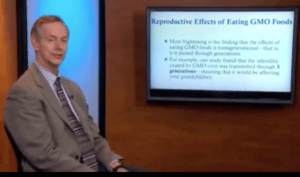One of the most heavily trafficked conservative-leaning websites on the Internet has now launched a fear-mongering campaign against GMOs. Set up as a rival to Fox News, Newsmax, which Donald Trump has called “one of the top media outlets in the country,” recently published a series of articles and a promotional video intended to persuade readers that GMOs are harmful to humans.
GMOs have been a particular focus of Newsmax, and its vitriol against the technology matches the hyperbole found on extremist leftist sites. In one of its latest articles, “Study: GMO Food is Dangerous,” the website hyped a three year old controversial rat study by French molecular biologist Gilles-Eric Séralini as if it were new news. The now infamous Seralini study–accompanied by a PR blitz including a book, movie and grotesque pictures of cancer-twisted rats–had claimed that rats feed GMO feed developed cancerous tumors. The study was widely derided at the time and later retraced, only to be republished without peer review in a pay for play journal–key factual points that managed to elude the writer and editors at Newsmax.
This kind of shoddy reporting, particularly on GMOs, is typical fare on Newsmax. In the last three months, Newsmax ran: “GMO Food — It’s Worse Than We Thought“; “Smart Moms are Saying ‘No to GMO Baby Food and Formula;” and “GMO Foods: Are They Safe?” No actual news is reported in any of the articles; all were ploys to get readers to click on a “special” report that links them to a promotional video. The singular objective of Newsmax’s videos and articles: hawking newsletters, books, and booklets and pushing alternative health cures and quack medicine in general.
The front man for Newsmax’s health related scare campaigns is Russell Blaylock, a former neurosurgeon turned conspiracy theorist and pseudoscience peddler, who is the author of the Newsmax-published “Blaylock Wellness Report” and the booklet “Cracking the GMO code package.” Blaylock also claims to be a reviewer for the journal Food and Chemical Toxicology, which published and then retracted the original Séralini study. He’s not, as the journal does not retain “reviewers.”
Blaylock described the Séralini study as “one of the best and one of the only long-term studies of the effect of genetically modified (GMO) foods and tumor induction.” Based on the results of the retracted study, Blaylock concludes, “In my estimation, all GMO foods should be removed from stores and GMO crops should be destroyed.” He also warns that all other studies supporting the safety of genetically modified crops are authored by organizations, including those funded by the World Health Organization (WHO), that come with “strong financial ties.”
Considering that anti-GMO propaganda production usually falls to environmental and activist groups that generally fall on the left side of the political spectrum, it’s right-wing leanings that make Newsmax and Blaylock somewhat distinctive. But like the Jeffrey Smiths, Joe Mercolas, or Food Babes of the world, who’ve made an art form out of misleading their audiences with articles and/or videos, their claims often might contain a kernel of truth, but are ultimately designed to confuse and scare consumers unnecessarily and often for a profit. Here’s the thing about Blaylock: he’s the kind of guy your mother and grandmother would trust—and the clean-cut, well-spoken doctor is quite effective in manufacturing a similar orthorexia-inducing message to sell his packages.
<!–

–>
No stranger to scare mongering for profit, Blaylock also previously wrote the book Excitotoxins: The Taste that Kills in which he claims that artificial sweeteners and food additives like aspartame (NutraSweet®) and monosodium glutamate (MSG) cause brain damage. His solution for the problem? His own self-developed “Brain Repair Formula” dietary supplement.
He’s also a frequent disseminator of conspiracy theories written about in his books and newsletters. These include allegations that aluminum nanoparticles are being purposely released into the atmosphere, or “chemtrails,” that mass fluoridation of water is used to control the population, and that vaccines are ineffective and promoted solely for the profit of the U.S. government and Big Pharma. For the latter, he was once named “Quack of the Day” by UK-based blog The Vaccine Conspiracy Theorist. The conspiracy theorist doc already has a popular following especially among certain conservative Christian circles, who he tailors his message to and who he notes are more receptive as opposed to his scientific colleagues.
Deconstructing an anti-GMO propaganda video
The highly charged promotional video that fuels the sales of Newsmax’s new booklet features Blaylock showing a PowerPoint. Besides describing the Séralini rat study in detail, he also reprises a variety of claims often ascribed by anti-GMO activists that are not supported by the scientific literature.
- Myth: Eating GMO ingredients leads to higher ingestion of herbicides increased risk of cancer.
<!–
–>
The video starts out with an actor who dunks an ear of genetically modified corn into about a gallon of glyphosate herbicide and then asks if you’d eat it. One of Blaylock’s main claims is that avoiding GMO ingredients is imperative because they have a high content of herbicides like glyphosate that will lead to serious chronic diseases, such as cancerous tumors as seen in Séralini’s study. “We see an almost two-and-a-half times increase in death rate in both males and females [rats in the study] consuming this GMO food. Most shocking is that these animals were dying prematurely even when they were eating the lower dose GMO foods,” Blaylock says.
The issue of dose should’ve been a clue that there were problems in the study. One of the major criticisms of Séralini’s paper, which reported findings that glyphosate-resistant corn and Roundup added to drinking water led to the development of a greater number of tumors in rats (along with photos of those tumors) was over its poor choice for animal model—Sprague Dawley rats are prone to development of tumors. There was also a lack of blinding between control and experimental groups, and cherry picking of results.
In addition, unlike dunking an ear of corn into a gallon of herbicide or spraying Roundup on popcorn, as also demonstrated in the video, the actual amount of herbicide on grocery produce would be negligible. Full-time farmer Dave Walton dismantles the claim that GMOs have high levels of herbicides: “On our corn ground, before planting we apply 16 ounces of Glyphosate, 8 ounces of 2,4-D, and 48 ounces of metalachlor per acre. To put that in perspective, it’s a little more than half a gallon of herbicide spread out over an acre, or roughly the size of a football field.”
- Myth: GM plants will increase your exposure to pesticides raising the risk of cancer.
All plants make natural pesticides, called phytoalexins, but GM plants produce high levels of them and constantly, Blaylock claims. “If you eat the plant then you’re getting very high levels of phytoalexins that are carcinogenic,” he says. And he claims those higher levels of pesticides, as well as the increased levels of herbicides, could lead to similar outcomes as seen in Séralini’s rats.
But the claim is largely misleading and doesn’t take into account that what may be toxic in to an insect would not harm a human. Take caffeine, for example, which is a type of pesticide that humans enjoy daily. In addition, the evidence is clear that GM crops, particularly Bt corn and Bt brinjal, that produce their own insecticide have led to reduction of overall pesticides used on those crops.
- Myth: GM plants will cross-pollinate until all plants are GMO.
One of the most pervasive myths that Blaylock refers to that surrounding cross pollination. “If you genetically modify a significant number of plants in your country and it blows the seeds into other fields and cross-pollinates, then all the plants will become genetically modified and eventually you could have 100 percent of all the plants in the United States and the world will become genetically modified,” he said.
Whether there is potential for a GM plant to cross-pollinate to a non-GM plant, however, can depend on several factors including the type of crop. In the case of soy, for example, it’s self-pollinating so there is little if any risk of cross-pollination. In addition, research on corn has found that cross-pollination only occurs within short distances and that a barrier of about 150 feet is enough to prevent any significant cross pollination from one field to another.
- Myth: Patented “terminal seeds” will force farmers to raise food prices.
Biotechnology companies purposely create “terminal seeds,” Blaylock claims, causing their plants to not produce their own seed. “This allows the company that makes the terminal seed to require the farmer to buy new seed every year. What that means to you as a consumer is that you’ll be paying a lot more for your food,” he said. However, the existence of terminal seeds, also known as “terminator seeds,” are not commercially available anywhere on the market. Nor do companies such as Monsanto intend on pursuing the option of producing them.
- Myth: Soy, especially GMO soy, increases the risk of breast cancer or make breast cancer more aggressive.
Even non-GMO soy products, Blaylock warns, increase risk of breast cancer or can make existing breast cancers “grow a lot faster” because of soy’s content of phytoestrogens and increased level of herbicides and pesticides (myths previously addressed). According to Marji McCullough of the American Cancer Society, however, there is no evidence that any soy foods or soy isolates are associated with increased risk of breast cancer or any cancers. While it’s well established that estrogen is associated with risk of hormonally sensitive cancers, in addition, studies have found that the consumption of soy foods have a “seeming protective” weak association women with estrogen-receptive tumors possibly because of a tamoxifen-like effect.
- Myth: Soy-based infant formula is estimated to provide the equivalent in estrogen as five contraceptive pills a day. And GMO soy is only worse.
Blaylock claims that if infants drink GMO soy formula, they are placed on the path of eating a diet high in GMO foods over a lifetime. “This is getting close to that mouse model,” he says, in reference to the Séralini study. Even non-GMO soy has its dangers because of its content of fluoride, aluminum, and glutamate, Blayock warns, and genetic modification only increases “health risk even further.” He says that soy formula also contains estrogen-like substances in amounts that are “equivalent to a baby receiving five contraceptive pills a day” and that they are “going to play a part” in whether an infant develops a “female brain” or a “male brain.”
While soy formula indeed does indeed supply phytoestrogens, there’s no scientific evidence of any adverse effects on sexual development or reproductive function in animals or humans with typical doses in soy formula, according to Dr. Jatinder Bhatia and Dr. Frank Greer of the American Academy of Pediatrics. Blaylock also fails to mention that other foods including milk, meat, and other plants also contain estrogen-like compounds and may potentially contribute much higher levels than what’s provided by soy in typical diets.
- Myth: GMOs cause inflammation, such as celery that causes serious burns to the mouth and hands.
GMO crops cause inflammation in the body, Blaylock claims, as demonstrated in a case where celery presented immediate inflammatory effects in harvesters of the crop. “When the workers would go pick the celery, and occasionally eat it, it would burn their mouth and burn their hands,” he explains. But there has been no case of GMO celery burning the mouths and hands of farm workers. The case of celery he’s likely referring to was actually a non-GMO variety of celery bred for pest resistance that was grown late in the season leading to having increased psoralens (a compound naturally produced by the plant) that can cause the skin to be extra sensitive to the sun.
- Myth: GMO foods cause offspring to have low fertility down through three generations.

Yet one of the most “frightening effects” of GMO crops, Blaylock claims, is its effects on the reproductive system. “If you take an animal and you feed it GMO foods during pregnancy, then you take the offspring, you find that it has low fertility, and if it does become pregnant, then the third generation also has low fertility,” he said. The reason, he says, is due to toxins passed through the placenta making the effect “trans-generational.” As an example, he cites a study that found that infertility across three generations was caused by GMO corn.
However, the research Blaylock was probably referring was that of reproductive failures due to mycotoxin contamination in non-GMO corn. The contamination was probably a result of poor growing or storage conditions, according to website AcademicsReview.org. Mycotoxins are a known cause of infertility and death in animals. Ironically, as journalist Rebecca Randall reports, GM corn has all but eliminated the risk of mycotoxin contamination as opposed to both non-GM conventional corn and organic corn. The reason is that Bt corn wards off pests that would allow infiltration of fungus into the crop that produce the mycotoxins.
- Myth: You can avoid GMOs by seeking out appropriate PLU codes.

Throughout the Newsmax video, viewers are reminded by the actor-narrator that they can also purchase Blaylock’s convenient 26-page booklet called “Cracking the GMO code package.” The booklet includes information on how you can avoid GMOs by simply seeking out the right PLU codes on produce at the grocery store. As reported by Snopes, however, there is a mix of truth in that. PLU codes on produce like corn can “identify qualities such as how food products were grown.” However, the PLU codes are optional and a lot of produce items don’t bear them at all.
With each myth described, what becomes more clear is the method by which these myths are produced: take some kind of study or fact, wrap it up in a way that blames a negative outcome on the idea that of genetic modification, use it to scare readers into believing GMOs might cause harm or even lead to early death. Despite whether a reader or viewer is conservative or liberal, the method works. Already Newsmax’s promotional video has been viewed more than 90,000 times and has generated more than 12,000 subscribers on YouTube since it was first published in December 2013. “Blaylock’s Wellness Report” is also said to have 100,000 “loyal readers,” speaking to the impact of the organization’s marketing. Regardless of the credibility of Newsmax or Blaylock, their anti-GMO tactics are indeed effective with uninformed audiences.
David Despain, M.Sc., is a science and health journalist based in Gilbert, Ariz. He is also director and managing editor of Bionomics, Genetic Literacy Project. Follow @daviddespain on Twitter.































